Impact of Natural Disasters on Stock Exchange Returns and Volatility
VerifiedAdded on 2022/09/16
|15
|4128
|17
Annotated Bibliography
AI Summary
This annotated bibliography examines the impact of natural disasters on stock exchange returns and volatility, drawing on a selection of key research papers. The bibliography begins with an analysis of the relationship between geopolitical risks, oil markets, and stock markets, highlighting how market reactions to exogenous events, including natural disasters, can significantly affect investor behavior and asset allocation. Several studies explore the effects of specific events, such as natural disasters, on the stock returns and volatilities of local firms, with findings indicating abnormal returns and increased volatility, particularly for companies located in affected areas. Further papers delve into the influence of climatic events on the Chinese stock market, demonstrating the varying effects of disasters on different industries and highlighting the importance of considering both domestic and international events. Additional research investigates the pricing of volatility risk and aggregate jump risk in stock returns, the impact of rare disaster risks on oil returns and volatility, and the role of outliers, time-varying jumps, and oil price risk in modeling and forecasting the volatility of the carbon emission market. The bibliography also covers the influence of major world events on stock market prices and the role of geopolitical risks in predicting volatility jumps. Overall, the annotated bibliography provides a comprehensive overview of the financial implications of natural disasters, offering valuable insights for finance professionals and researchers.
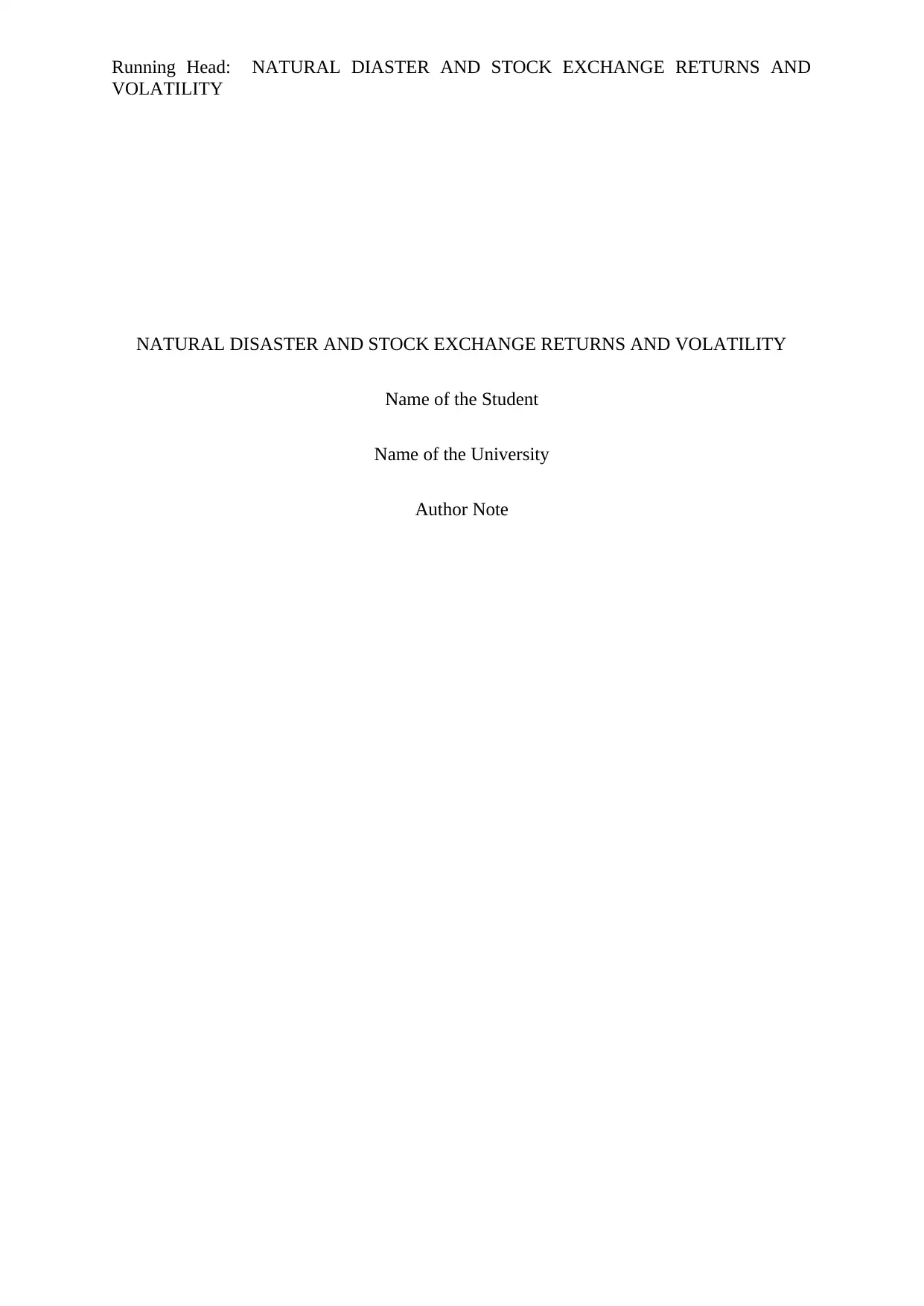
Running Head: NATURAL DIASTER AND STOCK EXCHANGE RETURNS AND
VOLATILITY
NATURAL DISASTER AND STOCK EXCHANGE RETURNS AND VOLATILITY
Name of the Student
Name of the University
Author Note
VOLATILITY
NATURAL DISASTER AND STOCK EXCHANGE RETURNS AND VOLATILITY
Name of the Student
Name of the University
Author Note
Paraphrase This Document
Need a fresh take? Get an instant paraphrase of this document with our AI Paraphraser
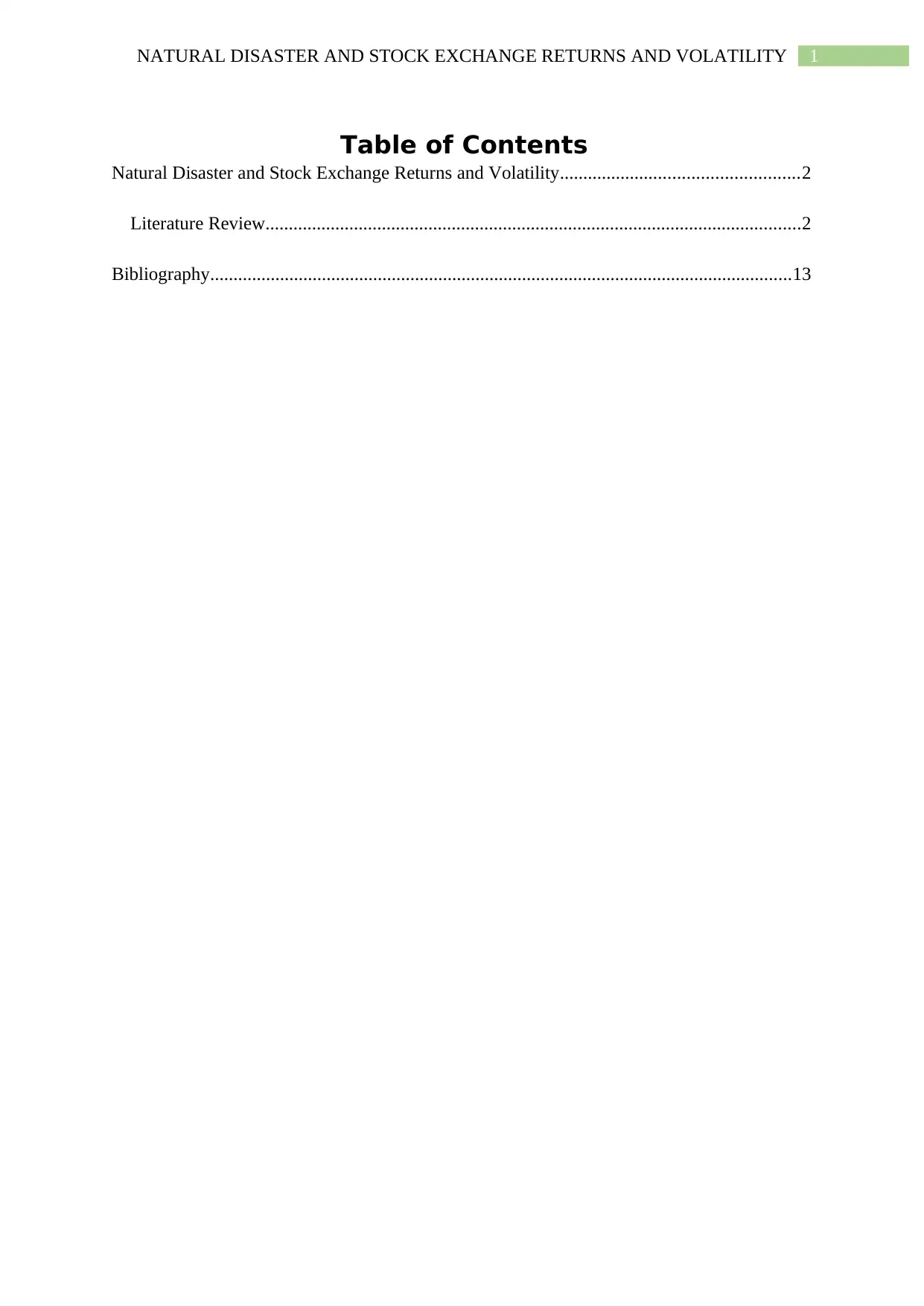
1NATURAL DISASTER AND STOCK EXCHANGE RETURNS AND VOLATILITY
Table of Contents
Natural Disaster and Stock Exchange Returns and Volatility...................................................2
Literature Review...................................................................................................................2
Bibliography.............................................................................................................................13
Table of Contents
Natural Disaster and Stock Exchange Returns and Volatility...................................................2
Literature Review...................................................................................................................2
Bibliography.............................................................................................................................13
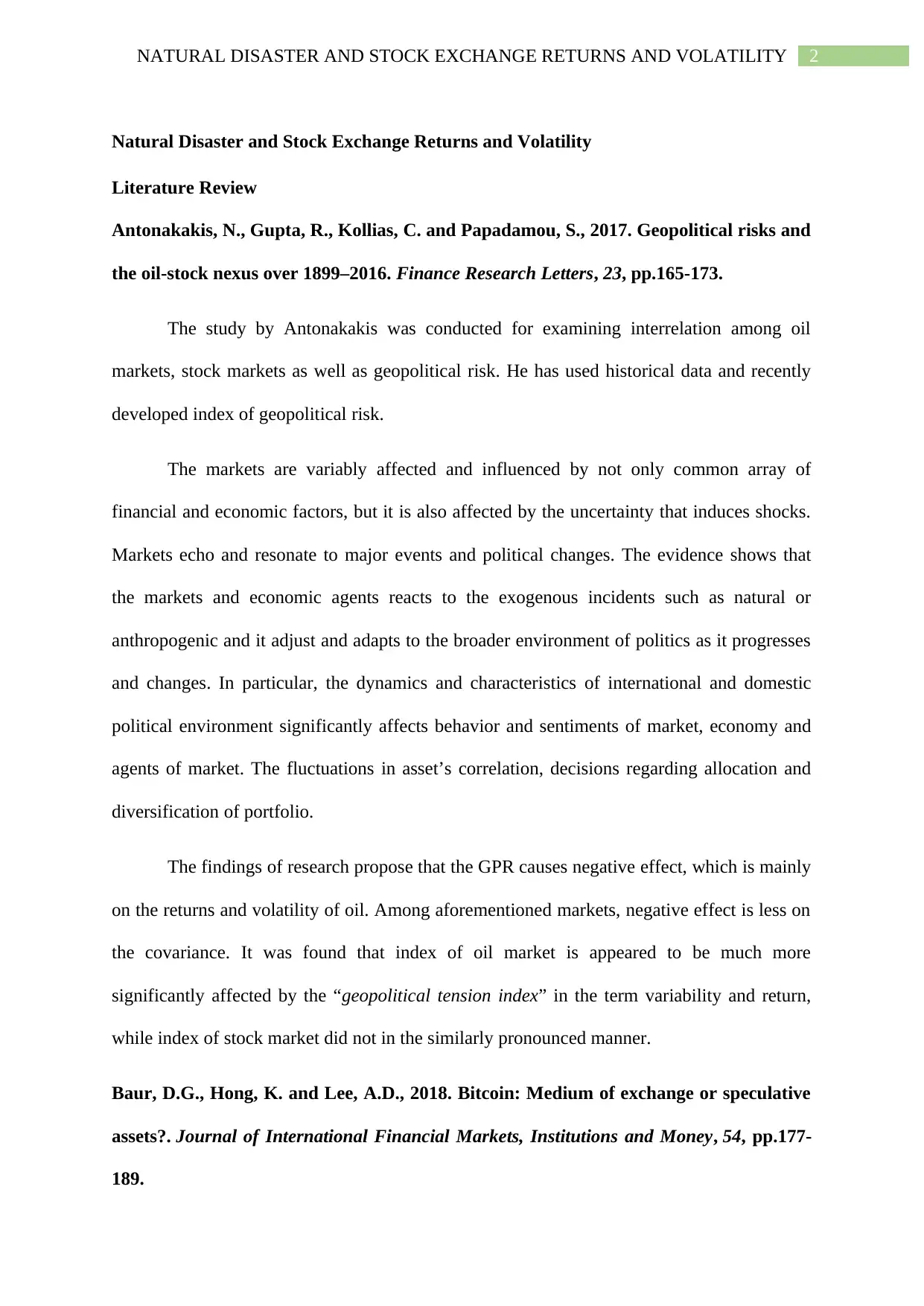
2NATURAL DISASTER AND STOCK EXCHANGE RETURNS AND VOLATILITY
Natural Disaster and Stock Exchange Returns and Volatility
Literature Review
Antonakakis, N., Gupta, R., Kollias, C. and Papadamou, S., 2017. Geopolitical risks and
the oil-stock nexus over 1899–2016. Finance Research Letters, 23, pp.165-173.
The study by Antonakakis was conducted for examining interrelation among oil
markets, stock markets as well as geopolitical risk. He has used historical data and recently
developed index of geopolitical risk.
The markets are variably affected and influenced by not only common array of
financial and economic factors, but it is also affected by the uncertainty that induces shocks.
Markets echo and resonate to major events and political changes. The evidence shows that
the markets and economic agents reacts to the exogenous incidents such as natural or
anthropogenic and it adjust and adapts to the broader environment of politics as it progresses
and changes. In particular, the dynamics and characteristics of international and domestic
political environment significantly affects behavior and sentiments of market, economy and
agents of market. The fluctuations in asset’s correlation, decisions regarding allocation and
diversification of portfolio.
The findings of research propose that the GPR causes negative effect, which is mainly
on the returns and volatility of oil. Among aforementioned markets, negative effect is less on
the covariance. It was found that index of oil market is appeared to be much more
significantly affected by the “geopolitical tension index” in the term variability and return,
while index of stock market did not in the similarly pronounced manner.
Baur, D.G., Hong, K. and Lee, A.D., 2018. Bitcoin: Medium of exchange or speculative
assets?. Journal of International Financial Markets, Institutions and Money, 54, pp.177-
189.
Natural Disaster and Stock Exchange Returns and Volatility
Literature Review
Antonakakis, N., Gupta, R., Kollias, C. and Papadamou, S., 2017. Geopolitical risks and
the oil-stock nexus over 1899–2016. Finance Research Letters, 23, pp.165-173.
The study by Antonakakis was conducted for examining interrelation among oil
markets, stock markets as well as geopolitical risk. He has used historical data and recently
developed index of geopolitical risk.
The markets are variably affected and influenced by not only common array of
financial and economic factors, but it is also affected by the uncertainty that induces shocks.
Markets echo and resonate to major events and political changes. The evidence shows that
the markets and economic agents reacts to the exogenous incidents such as natural or
anthropogenic and it adjust and adapts to the broader environment of politics as it progresses
and changes. In particular, the dynamics and characteristics of international and domestic
political environment significantly affects behavior and sentiments of market, economy and
agents of market. The fluctuations in asset’s correlation, decisions regarding allocation and
diversification of portfolio.
The findings of research propose that the GPR causes negative effect, which is mainly
on the returns and volatility of oil. Among aforementioned markets, negative effect is less on
the covariance. It was found that index of oil market is appeared to be much more
significantly affected by the “geopolitical tension index” in the term variability and return,
while index of stock market did not in the similarly pronounced manner.
Baur, D.G., Hong, K. and Lee, A.D., 2018. Bitcoin: Medium of exchange or speculative
assets?. Journal of International Financial Markets, Institutions and Money, 54, pp.177-
189.
⊘ This is a preview!⊘
Do you want full access?
Subscribe today to unlock all pages.

Trusted by 1+ million students worldwide
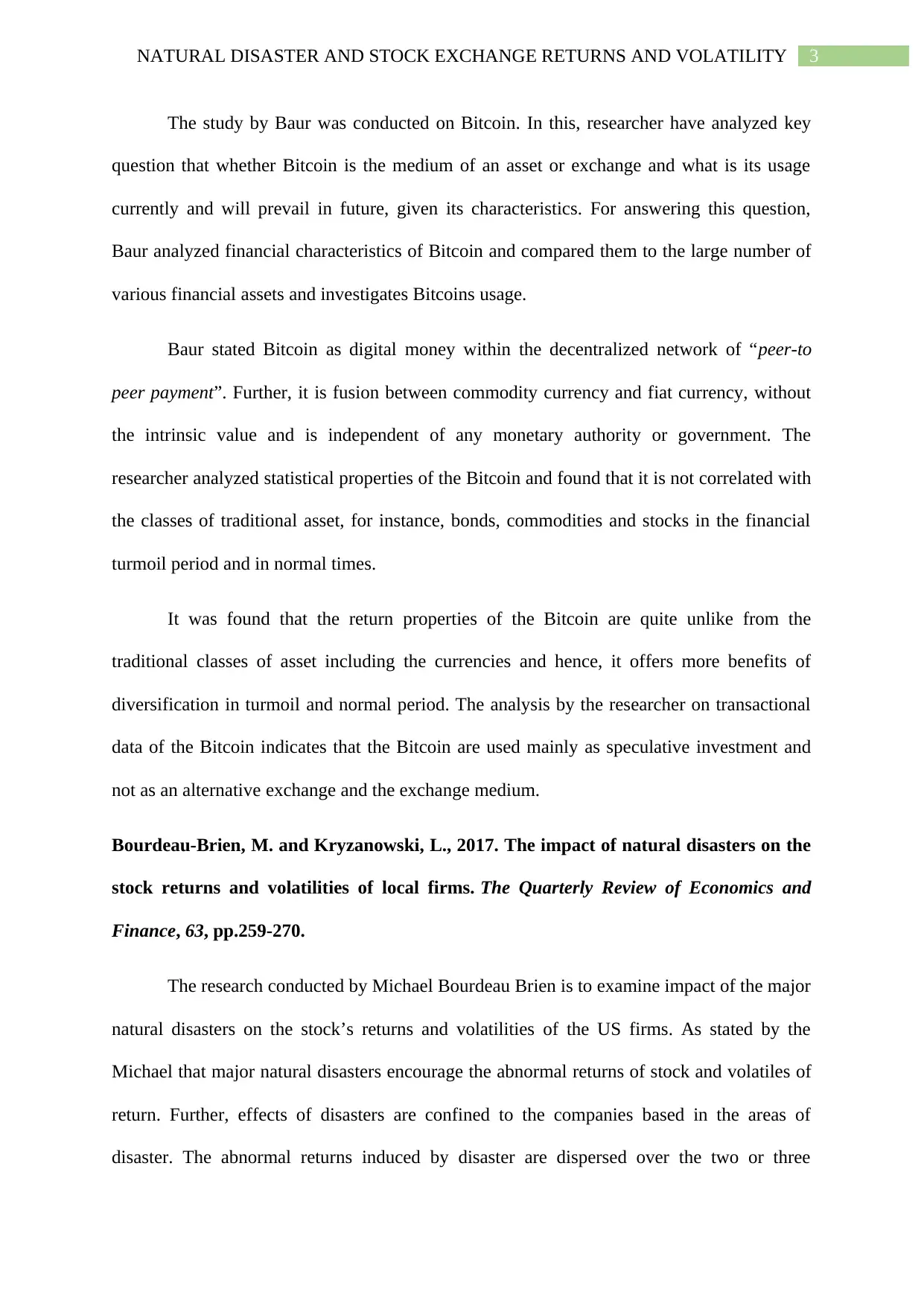
3NATURAL DISASTER AND STOCK EXCHANGE RETURNS AND VOLATILITY
The study by Baur was conducted on Bitcoin. In this, researcher have analyzed key
question that whether Bitcoin is the medium of an asset or exchange and what is its usage
currently and will prevail in future, given its characteristics. For answering this question,
Baur analyzed financial characteristics of Bitcoin and compared them to the large number of
various financial assets and investigates Bitcoins usage.
Baur stated Bitcoin as digital money within the decentralized network of “peer-to
peer payment”. Further, it is fusion between commodity currency and fiat currency, without
the intrinsic value and is independent of any monetary authority or government. The
researcher analyzed statistical properties of the Bitcoin and found that it is not correlated with
the classes of traditional asset, for instance, bonds, commodities and stocks in the financial
turmoil period and in normal times.
It was found that the return properties of the Bitcoin are quite unlike from the
traditional classes of asset including the currencies and hence, it offers more benefits of
diversification in turmoil and normal period. The analysis by the researcher on transactional
data of the Bitcoin indicates that the Bitcoin are used mainly as speculative investment and
not as an alternative exchange and the exchange medium.
Bourdeau-Brien, M. and Kryzanowski, L., 2017. The impact of natural disasters on the
stock returns and volatilities of local firms. The Quarterly Review of Economics and
Finance, 63, pp.259-270.
The research conducted by Michael Bourdeau Brien is to examine impact of the major
natural disasters on the stock’s returns and volatilities of the US firms. As stated by the
Michael that major natural disasters encourage the abnormal returns of stock and volatiles of
return. Further, effects of disasters are confined to the companies based in the areas of
disaster. The abnormal returns induced by disaster are dispersed over the two or three
The study by Baur was conducted on Bitcoin. In this, researcher have analyzed key
question that whether Bitcoin is the medium of an asset or exchange and what is its usage
currently and will prevail in future, given its characteristics. For answering this question,
Baur analyzed financial characteristics of Bitcoin and compared them to the large number of
various financial assets and investigates Bitcoins usage.
Baur stated Bitcoin as digital money within the decentralized network of “peer-to
peer payment”. Further, it is fusion between commodity currency and fiat currency, without
the intrinsic value and is independent of any monetary authority or government. The
researcher analyzed statistical properties of the Bitcoin and found that it is not correlated with
the classes of traditional asset, for instance, bonds, commodities and stocks in the financial
turmoil period and in normal times.
It was found that the return properties of the Bitcoin are quite unlike from the
traditional classes of asset including the currencies and hence, it offers more benefits of
diversification in turmoil and normal period. The analysis by the researcher on transactional
data of the Bitcoin indicates that the Bitcoin are used mainly as speculative investment and
not as an alternative exchange and the exchange medium.
Bourdeau-Brien, M. and Kryzanowski, L., 2017. The impact of natural disasters on the
stock returns and volatilities of local firms. The Quarterly Review of Economics and
Finance, 63, pp.259-270.
The research conducted by Michael Bourdeau Brien is to examine impact of the major
natural disasters on the stock’s returns and volatilities of the US firms. As stated by the
Michael that major natural disasters encourage the abnormal returns of stock and volatiles of
return. Further, effects of disasters are confined to the companies based in the areas of
disaster. The abnormal returns induced by disaster are dispersed over the two or three
Paraphrase This Document
Need a fresh take? Get an instant paraphrase of this document with our AI Paraphraser
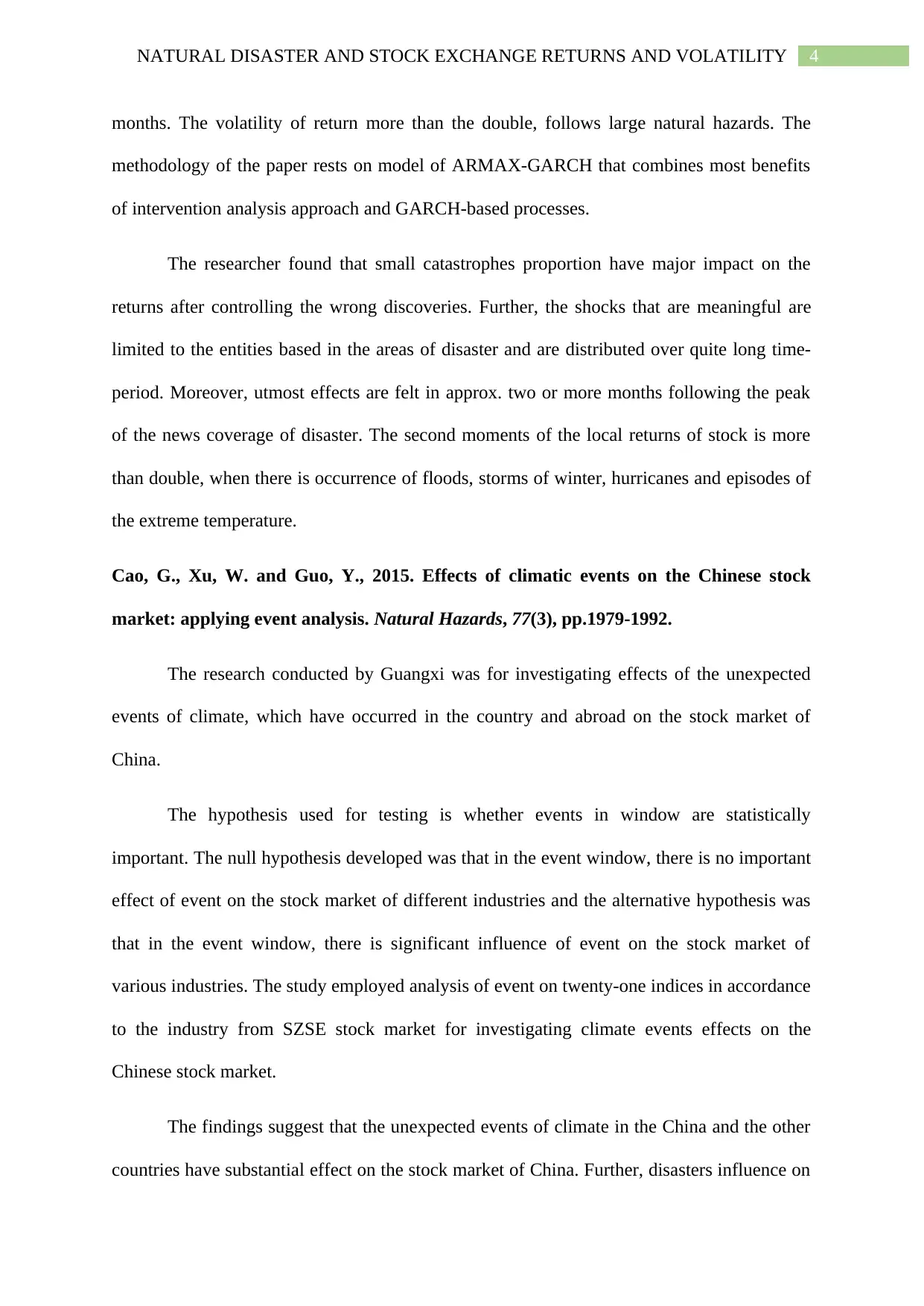
4NATURAL DISASTER AND STOCK EXCHANGE RETURNS AND VOLATILITY
months. The volatility of return more than the double, follows large natural hazards. The
methodology of the paper rests on model of ARMAX-GARCH that combines most benefits
of intervention analysis approach and GARCH-based processes.
The researcher found that small catastrophes proportion have major impact on the
returns after controlling the wrong discoveries. Further, the shocks that are meaningful are
limited to the entities based in the areas of disaster and are distributed over quite long time-
period. Moreover, utmost effects are felt in approx. two or more months following the peak
of the news coverage of disaster. The second moments of the local returns of stock is more
than double, when there is occurrence of floods, storms of winter, hurricanes and episodes of
the extreme temperature.
Cao, G., Xu, W. and Guo, Y., 2015. Effects of climatic events on the Chinese stock
market: applying event analysis. Natural Hazards, 77(3), pp.1979-1992.
The research conducted by Guangxi was for investigating effects of the unexpected
events of climate, which have occurred in the country and abroad on the stock market of
China.
The hypothesis used for testing is whether events in window are statistically
important. The null hypothesis developed was that in the event window, there is no important
effect of event on the stock market of different industries and the alternative hypothesis was
that in the event window, there is significant influence of event on the stock market of
various industries. The study employed analysis of event on twenty-one indices in accordance
to the industry from SZSE stock market for investigating climate events effects on the
Chinese stock market.
The findings suggest that the unexpected events of climate in the China and the other
countries have substantial effect on the stock market of China. Further, disasters influence on
months. The volatility of return more than the double, follows large natural hazards. The
methodology of the paper rests on model of ARMAX-GARCH that combines most benefits
of intervention analysis approach and GARCH-based processes.
The researcher found that small catastrophes proportion have major impact on the
returns after controlling the wrong discoveries. Further, the shocks that are meaningful are
limited to the entities based in the areas of disaster and are distributed over quite long time-
period. Moreover, utmost effects are felt in approx. two or more months following the peak
of the news coverage of disaster. The second moments of the local returns of stock is more
than double, when there is occurrence of floods, storms of winter, hurricanes and episodes of
the extreme temperature.
Cao, G., Xu, W. and Guo, Y., 2015. Effects of climatic events on the Chinese stock
market: applying event analysis. Natural Hazards, 77(3), pp.1979-1992.
The research conducted by Guangxi was for investigating effects of the unexpected
events of climate, which have occurred in the country and abroad on the stock market of
China.
The hypothesis used for testing is whether events in window are statistically
important. The null hypothesis developed was that in the event window, there is no important
effect of event on the stock market of different industries and the alternative hypothesis was
that in the event window, there is significant influence of event on the stock market of
various industries. The study employed analysis of event on twenty-one indices in accordance
to the industry from SZSE stock market for investigating climate events effects on the
Chinese stock market.
The findings suggest that the unexpected events of climate in the China and the other
countries have substantial effect on the stock market of China. Further, disasters influence on
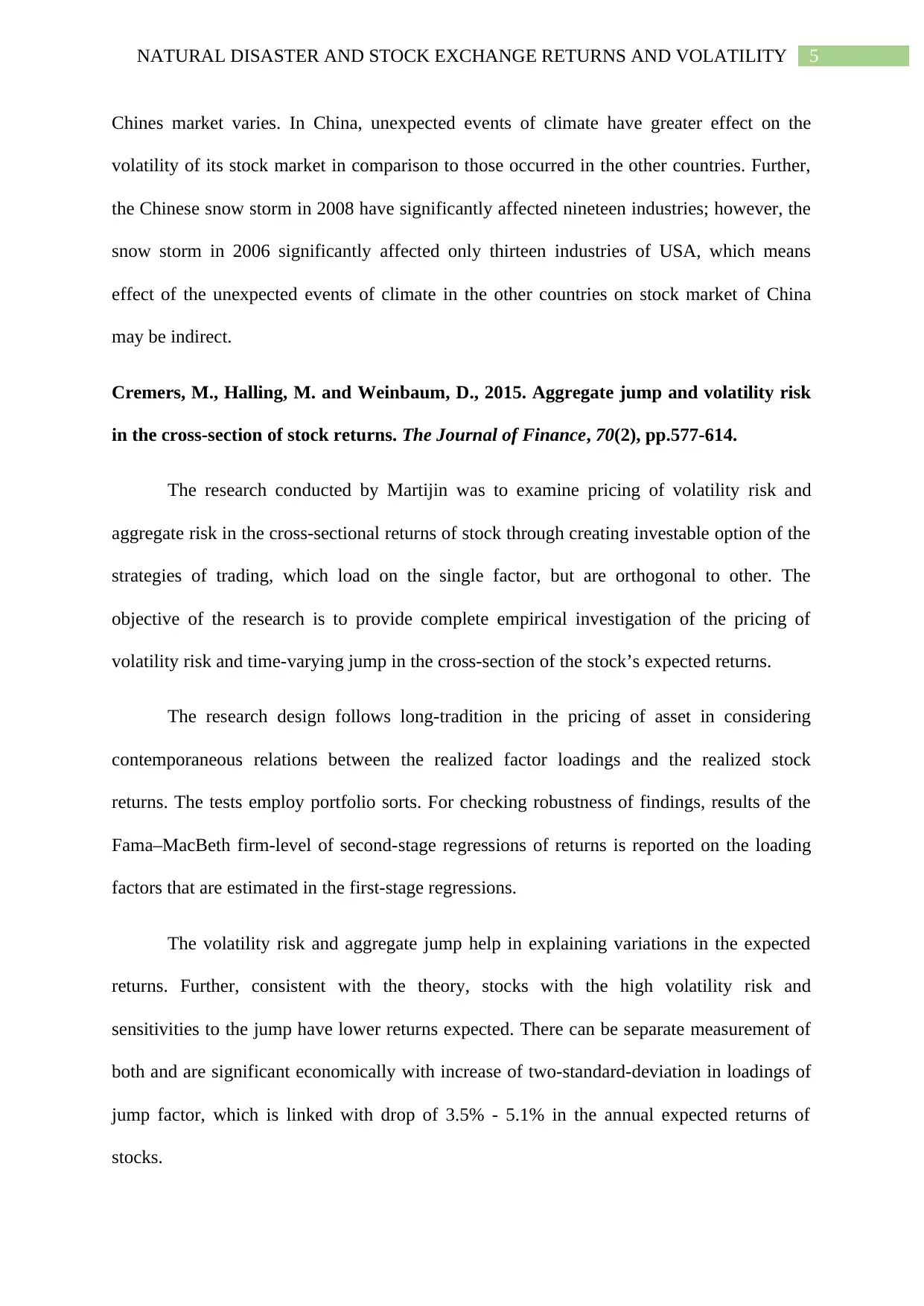
5NATURAL DISASTER AND STOCK EXCHANGE RETURNS AND VOLATILITY
Chines market varies. In China, unexpected events of climate have greater effect on the
volatility of its stock market in comparison to those occurred in the other countries. Further,
the Chinese snow storm in 2008 have significantly affected nineteen industries; however, the
snow storm in 2006 significantly affected only thirteen industries of USA, which means
effect of the unexpected events of climate in the other countries on stock market of China
may be indirect.
Cremers, M., Halling, M. and Weinbaum, D., 2015. Aggregate jump and volatility risk
in the cross‐section of stock returns. The Journal of Finance, 70(2), pp.577-614.
The research conducted by Martijin was to examine pricing of volatility risk and
aggregate risk in the cross-sectional returns of stock through creating investable option of the
strategies of trading, which load on the single factor, but are orthogonal to other. The
objective of the research is to provide complete empirical investigation of the pricing of
volatility risk and time-varying jump in the cross-section of the stock’s expected returns.
The research design follows long-tradition in the pricing of asset in considering
contemporaneous relations between the realized factor loadings and the realized stock
returns. The tests employ portfolio sorts. For checking robustness of findings, results of the
Fama–MacBeth firm-level of second-stage regressions of returns is reported on the loading
factors that are estimated in the first-stage regressions.
The volatility risk and aggregate jump help in explaining variations in the expected
returns. Further, consistent with the theory, stocks with the high volatility risk and
sensitivities to the jump have lower returns expected. There can be separate measurement of
both and are significant economically with increase of two-standard-deviation in loadings of
jump factor, which is linked with drop of 3.5% - 5.1% in the annual expected returns of
stocks.
Chines market varies. In China, unexpected events of climate have greater effect on the
volatility of its stock market in comparison to those occurred in the other countries. Further,
the Chinese snow storm in 2008 have significantly affected nineteen industries; however, the
snow storm in 2006 significantly affected only thirteen industries of USA, which means
effect of the unexpected events of climate in the other countries on stock market of China
may be indirect.
Cremers, M., Halling, M. and Weinbaum, D., 2015. Aggregate jump and volatility risk
in the cross‐section of stock returns. The Journal of Finance, 70(2), pp.577-614.
The research conducted by Martijin was to examine pricing of volatility risk and
aggregate risk in the cross-sectional returns of stock through creating investable option of the
strategies of trading, which load on the single factor, but are orthogonal to other. The
objective of the research is to provide complete empirical investigation of the pricing of
volatility risk and time-varying jump in the cross-section of the stock’s expected returns.
The research design follows long-tradition in the pricing of asset in considering
contemporaneous relations between the realized factor loadings and the realized stock
returns. The tests employ portfolio sorts. For checking robustness of findings, results of the
Fama–MacBeth firm-level of second-stage regressions of returns is reported on the loading
factors that are estimated in the first-stage regressions.
The volatility risk and aggregate jump help in explaining variations in the expected
returns. Further, consistent with the theory, stocks with the high volatility risk and
sensitivities to the jump have lower returns expected. There can be separate measurement of
both and are significant economically with increase of two-standard-deviation in loadings of
jump factor, which is linked with drop of 3.5% - 5.1% in the annual expected returns of
stocks.
⊘ This is a preview!⊘
Do you want full access?
Subscribe today to unlock all pages.

Trusted by 1+ million students worldwide
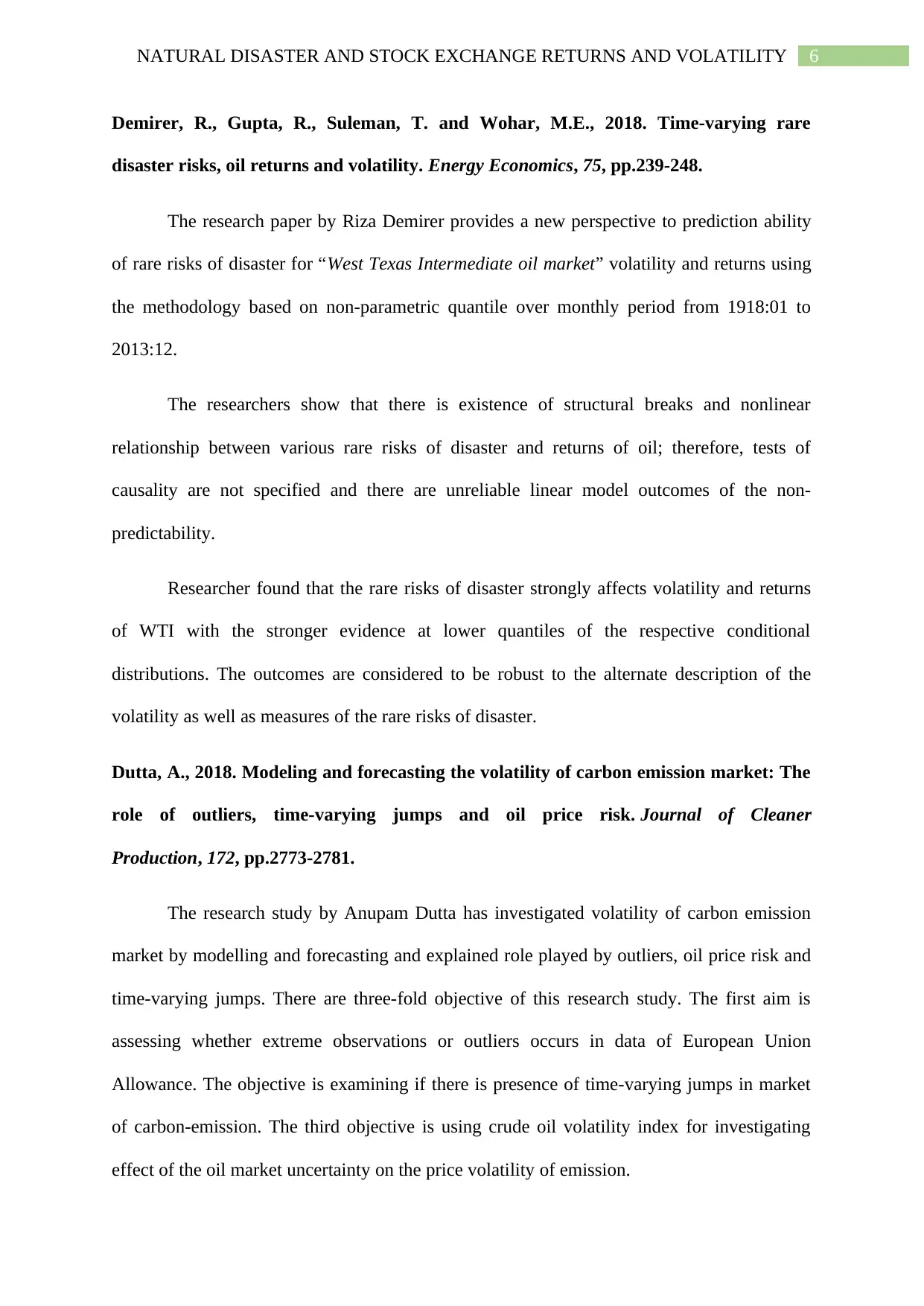
6NATURAL DISASTER AND STOCK EXCHANGE RETURNS AND VOLATILITY
Demirer, R., Gupta, R., Suleman, T. and Wohar, M.E., 2018. Time-varying rare
disaster risks, oil returns and volatility. Energy Economics, 75, pp.239-248.
The research paper by Riza Demirer provides a new perspective to prediction ability
of rare risks of disaster for “West Texas Intermediate oil market” volatility and returns using
the methodology based on non-parametric quantile over monthly period from 1918:01 to
2013:12.
The researchers show that there is existence of structural breaks and nonlinear
relationship between various rare risks of disaster and returns of oil; therefore, tests of
causality are not specified and there are unreliable linear model outcomes of the non-
predictability.
Researcher found that the rare risks of disaster strongly affects volatility and returns
of WTI with the stronger evidence at lower quantiles of the respective conditional
distributions. The outcomes are considered to be robust to the alternate description of the
volatility as well as measures of the rare risks of disaster.
Dutta, A., 2018. Modeling and forecasting the volatility of carbon emission market: The
role of outliers, time-varying jumps and oil price risk. Journal of Cleaner
Production, 172, pp.2773-2781.
The research study by Anupam Dutta has investigated volatility of carbon emission
market by modelling and forecasting and explained role played by outliers, oil price risk and
time-varying jumps. There are three-fold objective of this research study. The first aim is
assessing whether extreme observations or outliers occurs in data of European Union
Allowance. The objective is examining if there is presence of time-varying jumps in market
of carbon-emission. The third objective is using crude oil volatility index for investigating
effect of the oil market uncertainty on the price volatility of emission.
Demirer, R., Gupta, R., Suleman, T. and Wohar, M.E., 2018. Time-varying rare
disaster risks, oil returns and volatility. Energy Economics, 75, pp.239-248.
The research paper by Riza Demirer provides a new perspective to prediction ability
of rare risks of disaster for “West Texas Intermediate oil market” volatility and returns using
the methodology based on non-parametric quantile over monthly period from 1918:01 to
2013:12.
The researchers show that there is existence of structural breaks and nonlinear
relationship between various rare risks of disaster and returns of oil; therefore, tests of
causality are not specified and there are unreliable linear model outcomes of the non-
predictability.
Researcher found that the rare risks of disaster strongly affects volatility and returns
of WTI with the stronger evidence at lower quantiles of the respective conditional
distributions. The outcomes are considered to be robust to the alternate description of the
volatility as well as measures of the rare risks of disaster.
Dutta, A., 2018. Modeling and forecasting the volatility of carbon emission market: The
role of outliers, time-varying jumps and oil price risk. Journal of Cleaner
Production, 172, pp.2773-2781.
The research study by Anupam Dutta has investigated volatility of carbon emission
market by modelling and forecasting and explained role played by outliers, oil price risk and
time-varying jumps. There are three-fold objective of this research study. The first aim is
assessing whether extreme observations or outliers occurs in data of European Union
Allowance. The objective is examining if there is presence of time-varying jumps in market
of carbon-emission. The third objective is using crude oil volatility index for investigating
effect of the oil market uncertainty on the price volatility of emission.
Paraphrase This Document
Need a fresh take? Get an instant paraphrase of this document with our AI Paraphraser
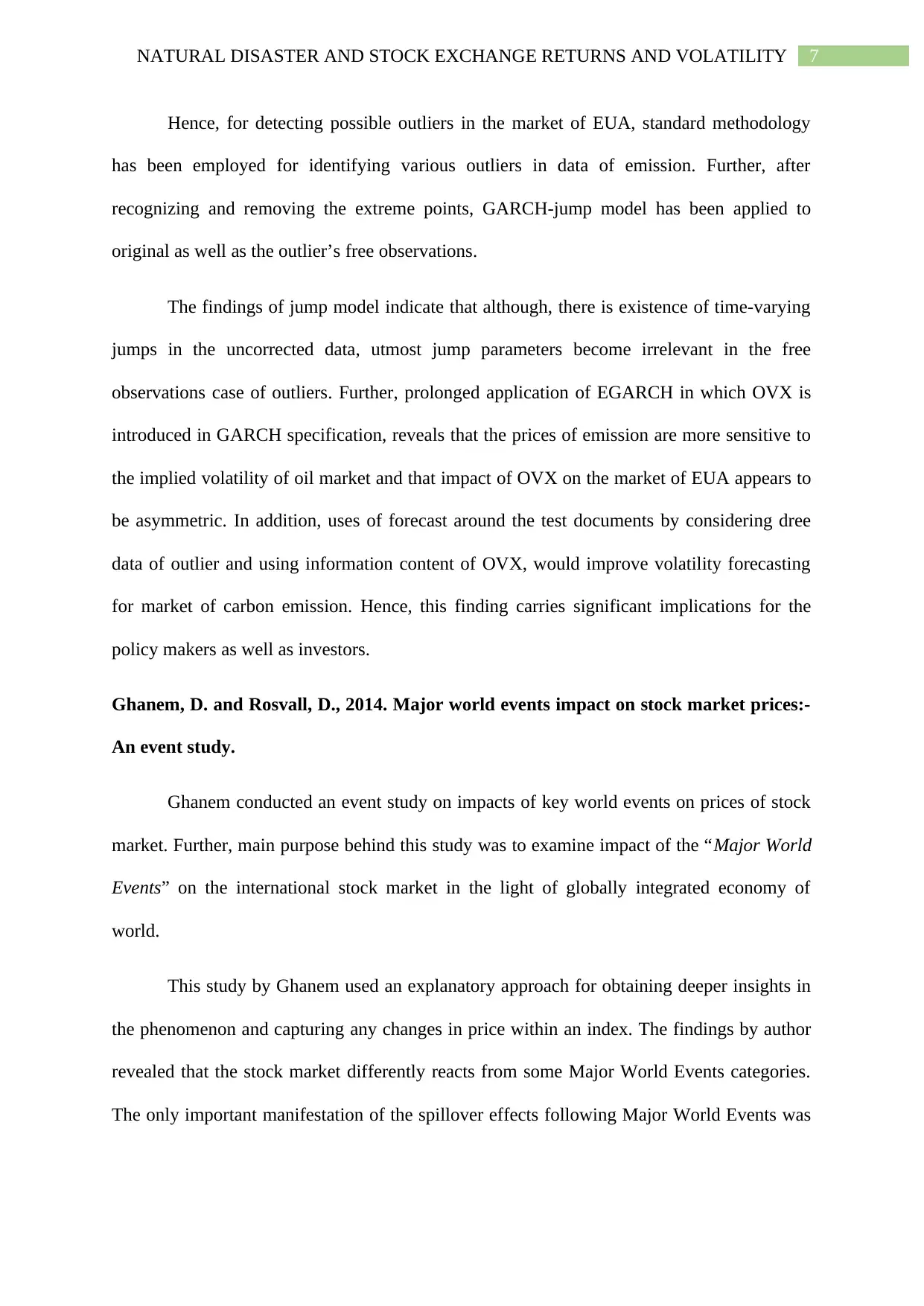
7NATURAL DISASTER AND STOCK EXCHANGE RETURNS AND VOLATILITY
Hence, for detecting possible outliers in the market of EUA, standard methodology
has been employed for identifying various outliers in data of emission. Further, after
recognizing and removing the extreme points, GARCH-jump model has been applied to
original as well as the outlier’s free observations.
The findings of jump model indicate that although, there is existence of time-varying
jumps in the uncorrected data, utmost jump parameters become irrelevant in the free
observations case of outliers. Further, prolonged application of EGARCH in which OVX is
introduced in GARCH specification, reveals that the prices of emission are more sensitive to
the implied volatility of oil market and that impact of OVX on the market of EUA appears to
be asymmetric. In addition, uses of forecast around the test documents by considering dree
data of outlier and using information content of OVX, would improve volatility forecasting
for market of carbon emission. Hence, this finding carries significant implications for the
policy makers as well as investors.
Ghanem, D. and Rosvall, D., 2014. Major world events impact on stock market prices:-
An event study.
Ghanem conducted an event study on impacts of key world events on prices of stock
market. Further, main purpose behind this study was to examine impact of the “Major World
Events” on the international stock market in the light of globally integrated economy of
world.
This study by Ghanem used an explanatory approach for obtaining deeper insights in
the phenomenon and capturing any changes in price within an index. The findings by author
revealed that the stock market differently reacts from some Major World Events categories.
The only important manifestation of the spillover effects following Major World Events was
Hence, for detecting possible outliers in the market of EUA, standard methodology
has been employed for identifying various outliers in data of emission. Further, after
recognizing and removing the extreme points, GARCH-jump model has been applied to
original as well as the outlier’s free observations.
The findings of jump model indicate that although, there is existence of time-varying
jumps in the uncorrected data, utmost jump parameters become irrelevant in the free
observations case of outliers. Further, prolonged application of EGARCH in which OVX is
introduced in GARCH specification, reveals that the prices of emission are more sensitive to
the implied volatility of oil market and that impact of OVX on the market of EUA appears to
be asymmetric. In addition, uses of forecast around the test documents by considering dree
data of outlier and using information content of OVX, would improve volatility forecasting
for market of carbon emission. Hence, this finding carries significant implications for the
policy makers as well as investors.
Ghanem, D. and Rosvall, D., 2014. Major world events impact on stock market prices:-
An event study.
Ghanem conducted an event study on impacts of key world events on prices of stock
market. Further, main purpose behind this study was to examine impact of the “Major World
Events” on the international stock market in the light of globally integrated economy of
world.
This study by Ghanem used an explanatory approach for obtaining deeper insights in
the phenomenon and capturing any changes in price within an index. The findings by author
revealed that the stock market differently reacts from some Major World Events categories.
The only important manifestation of the spillover effects following Major World Events was
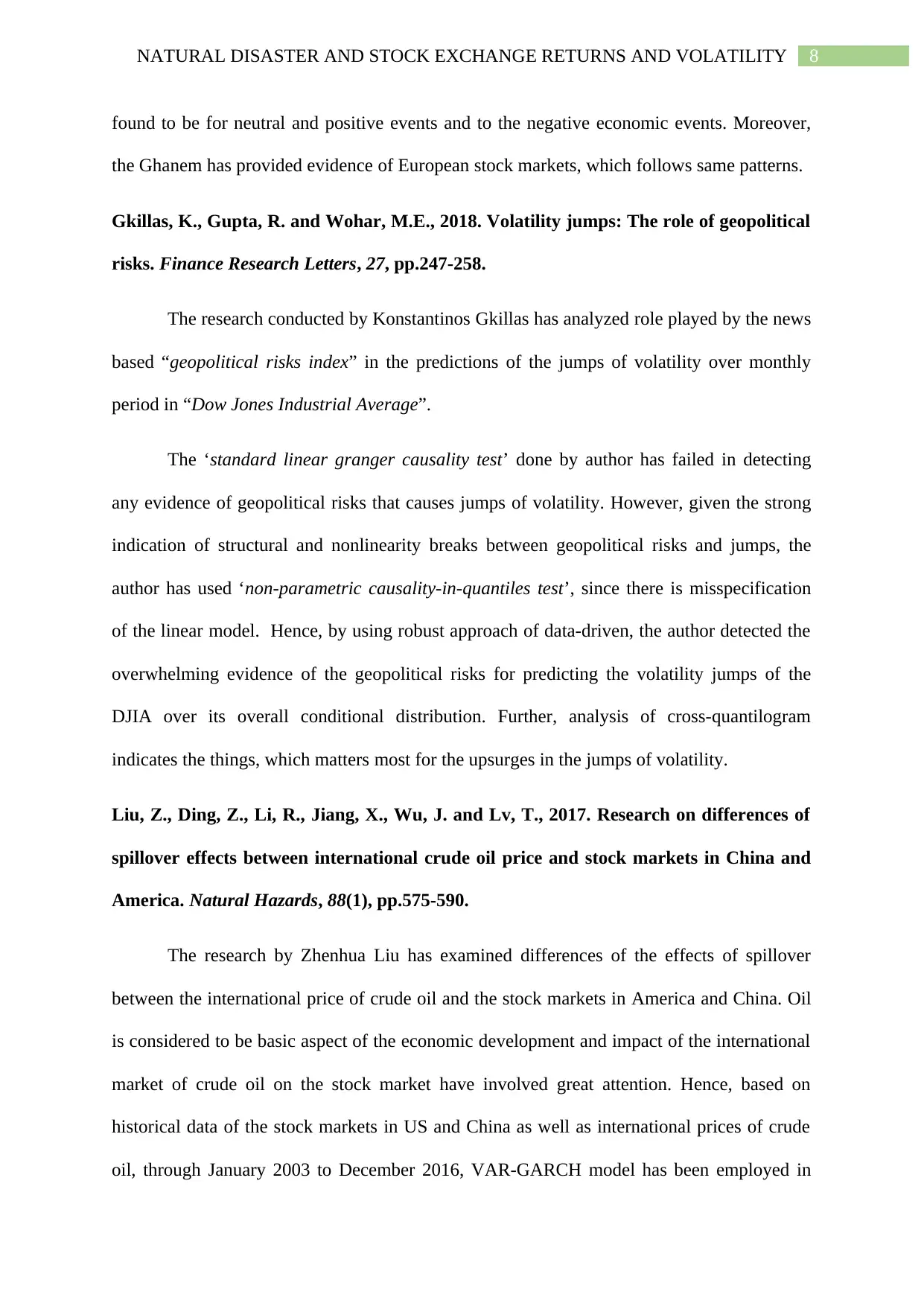
8NATURAL DISASTER AND STOCK EXCHANGE RETURNS AND VOLATILITY
found to be for neutral and positive events and to the negative economic events. Moreover,
the Ghanem has provided evidence of European stock markets, which follows same patterns.
Gkillas, K., Gupta, R. and Wohar, M.E., 2018. Volatility jumps: The role of geopolitical
risks. Finance Research Letters, 27, pp.247-258.
The research conducted by Konstantinos Gkillas has analyzed role played by the news
based “geopolitical risks index” in the predictions of the jumps of volatility over monthly
period in “Dow Jones Industrial Average”.
The ‘standard linear granger causality test’ done by author has failed in detecting
any evidence of geopolitical risks that causes jumps of volatility. However, given the strong
indication of structural and nonlinearity breaks between geopolitical risks and jumps, the
author has used ‘non-parametric causality-in-quantiles test’, since there is misspecification
of the linear model. Hence, by using robust approach of data-driven, the author detected the
overwhelming evidence of the geopolitical risks for predicting the volatility jumps of the
DJIA over its overall conditional distribution. Further, analysis of cross-quantilogram
indicates the things, which matters most for the upsurges in the jumps of volatility.
Liu, Z., Ding, Z., Li, R., Jiang, X., Wu, J. and Lv, T., 2017. Research on differences of
spillover effects between international crude oil price and stock markets in China and
America. Natural Hazards, 88(1), pp.575-590.
The research by Zhenhua Liu has examined differences of the effects of spillover
between the international price of crude oil and the stock markets in America and China. Oil
is considered to be basic aspect of the economic development and impact of the international
market of crude oil on the stock market have involved great attention. Hence, based on
historical data of the stock markets in US and China as well as international prices of crude
oil, through January 2003 to December 2016, VAR-GARCH model has been employed in
found to be for neutral and positive events and to the negative economic events. Moreover,
the Ghanem has provided evidence of European stock markets, which follows same patterns.
Gkillas, K., Gupta, R. and Wohar, M.E., 2018. Volatility jumps: The role of geopolitical
risks. Finance Research Letters, 27, pp.247-258.
The research conducted by Konstantinos Gkillas has analyzed role played by the news
based “geopolitical risks index” in the predictions of the jumps of volatility over monthly
period in “Dow Jones Industrial Average”.
The ‘standard linear granger causality test’ done by author has failed in detecting
any evidence of geopolitical risks that causes jumps of volatility. However, given the strong
indication of structural and nonlinearity breaks between geopolitical risks and jumps, the
author has used ‘non-parametric causality-in-quantiles test’, since there is misspecification
of the linear model. Hence, by using robust approach of data-driven, the author detected the
overwhelming evidence of the geopolitical risks for predicting the volatility jumps of the
DJIA over its overall conditional distribution. Further, analysis of cross-quantilogram
indicates the things, which matters most for the upsurges in the jumps of volatility.
Liu, Z., Ding, Z., Li, R., Jiang, X., Wu, J. and Lv, T., 2017. Research on differences of
spillover effects between international crude oil price and stock markets in China and
America. Natural Hazards, 88(1), pp.575-590.
The research by Zhenhua Liu has examined differences of the effects of spillover
between the international price of crude oil and the stock markets in America and China. Oil
is considered to be basic aspect of the economic development and impact of the international
market of crude oil on the stock market have involved great attention. Hence, based on
historical data of the stock markets in US and China as well as international prices of crude
oil, through January 2003 to December 2016, VAR-GARCH model has been employed in
⊘ This is a preview!⊘
Do you want full access?
Subscribe today to unlock all pages.

Trusted by 1+ million students worldwide
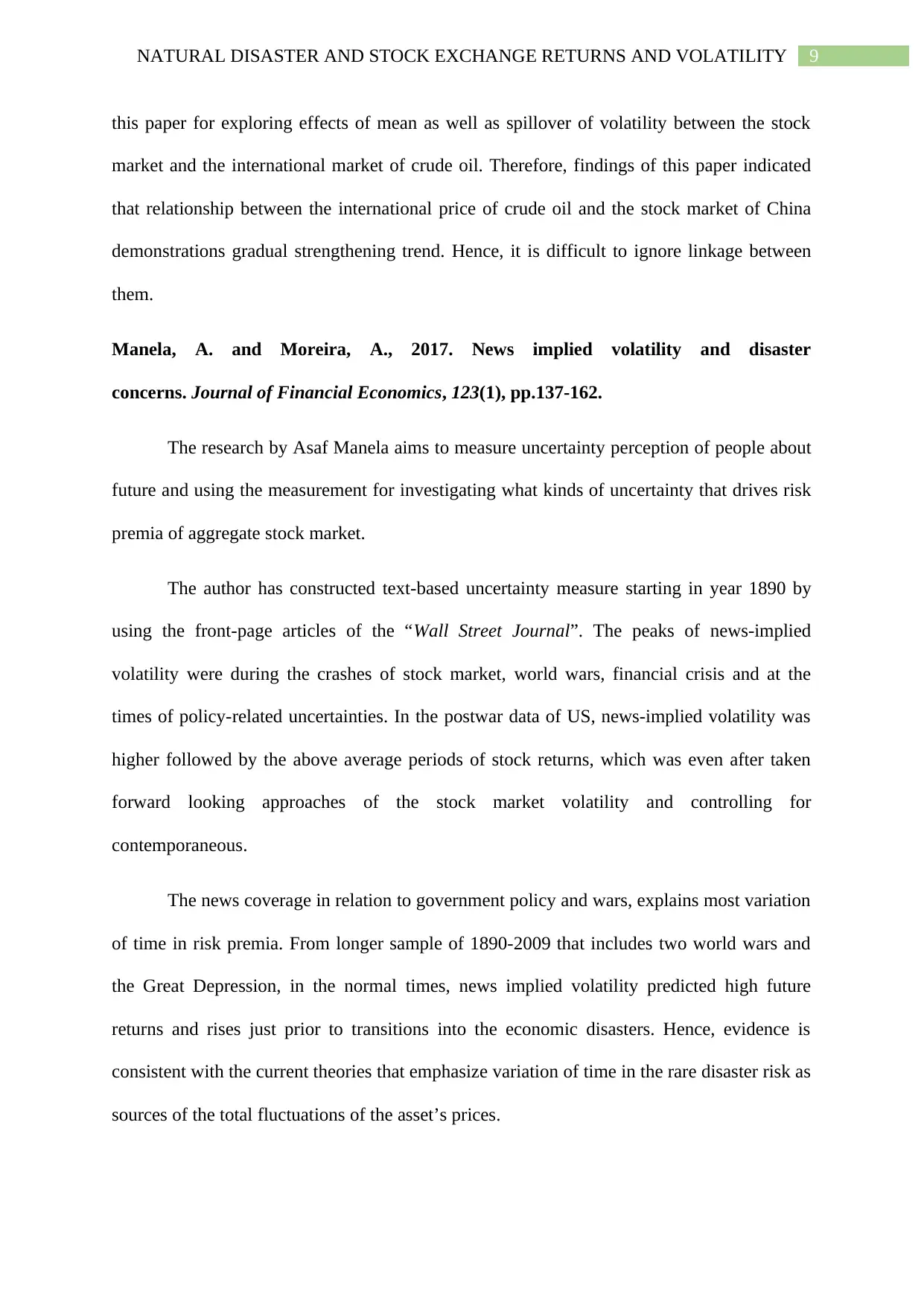
9NATURAL DISASTER AND STOCK EXCHANGE RETURNS AND VOLATILITY
this paper for exploring effects of mean as well as spillover of volatility between the stock
market and the international market of crude oil. Therefore, findings of this paper indicated
that relationship between the international price of crude oil and the stock market of China
demonstrations gradual strengthening trend. Hence, it is difficult to ignore linkage between
them.
Manela, A. and Moreira, A., 2017. News implied volatility and disaster
concerns. Journal of Financial Economics, 123(1), pp.137-162.
The research by Asaf Manela aims to measure uncertainty perception of people about
future and using the measurement for investigating what kinds of uncertainty that drives risk
premia of aggregate stock market.
The author has constructed text-based uncertainty measure starting in year 1890 by
using the front-page articles of the “Wall Street Journal”. The peaks of news-implied
volatility were during the crashes of stock market, world wars, financial crisis and at the
times of policy-related uncertainties. In the postwar data of US, news-implied volatility was
higher followed by the above average periods of stock returns, which was even after taken
forward looking approaches of the stock market volatility and controlling for
contemporaneous.
The news coverage in relation to government policy and wars, explains most variation
of time in risk premia. From longer sample of 1890-2009 that includes two world wars and
the Great Depression, in the normal times, news implied volatility predicted high future
returns and rises just prior to transitions into the economic disasters. Hence, evidence is
consistent with the current theories that emphasize variation of time in the rare disaster risk as
sources of the total fluctuations of the asset’s prices.
this paper for exploring effects of mean as well as spillover of volatility between the stock
market and the international market of crude oil. Therefore, findings of this paper indicated
that relationship between the international price of crude oil and the stock market of China
demonstrations gradual strengthening trend. Hence, it is difficult to ignore linkage between
them.
Manela, A. and Moreira, A., 2017. News implied volatility and disaster
concerns. Journal of Financial Economics, 123(1), pp.137-162.
The research by Asaf Manela aims to measure uncertainty perception of people about
future and using the measurement for investigating what kinds of uncertainty that drives risk
premia of aggregate stock market.
The author has constructed text-based uncertainty measure starting in year 1890 by
using the front-page articles of the “Wall Street Journal”. The peaks of news-implied
volatility were during the crashes of stock market, world wars, financial crisis and at the
times of policy-related uncertainties. In the postwar data of US, news-implied volatility was
higher followed by the above average periods of stock returns, which was even after taken
forward looking approaches of the stock market volatility and controlling for
contemporaneous.
The news coverage in relation to government policy and wars, explains most variation
of time in risk premia. From longer sample of 1890-2009 that includes two world wars and
the Great Depression, in the normal times, news implied volatility predicted high future
returns and rises just prior to transitions into the economic disasters. Hence, evidence is
consistent with the current theories that emphasize variation of time in the rare disaster risk as
sources of the total fluctuations of the asset’s prices.
Paraphrase This Document
Need a fresh take? Get an instant paraphrase of this document with our AI Paraphraser
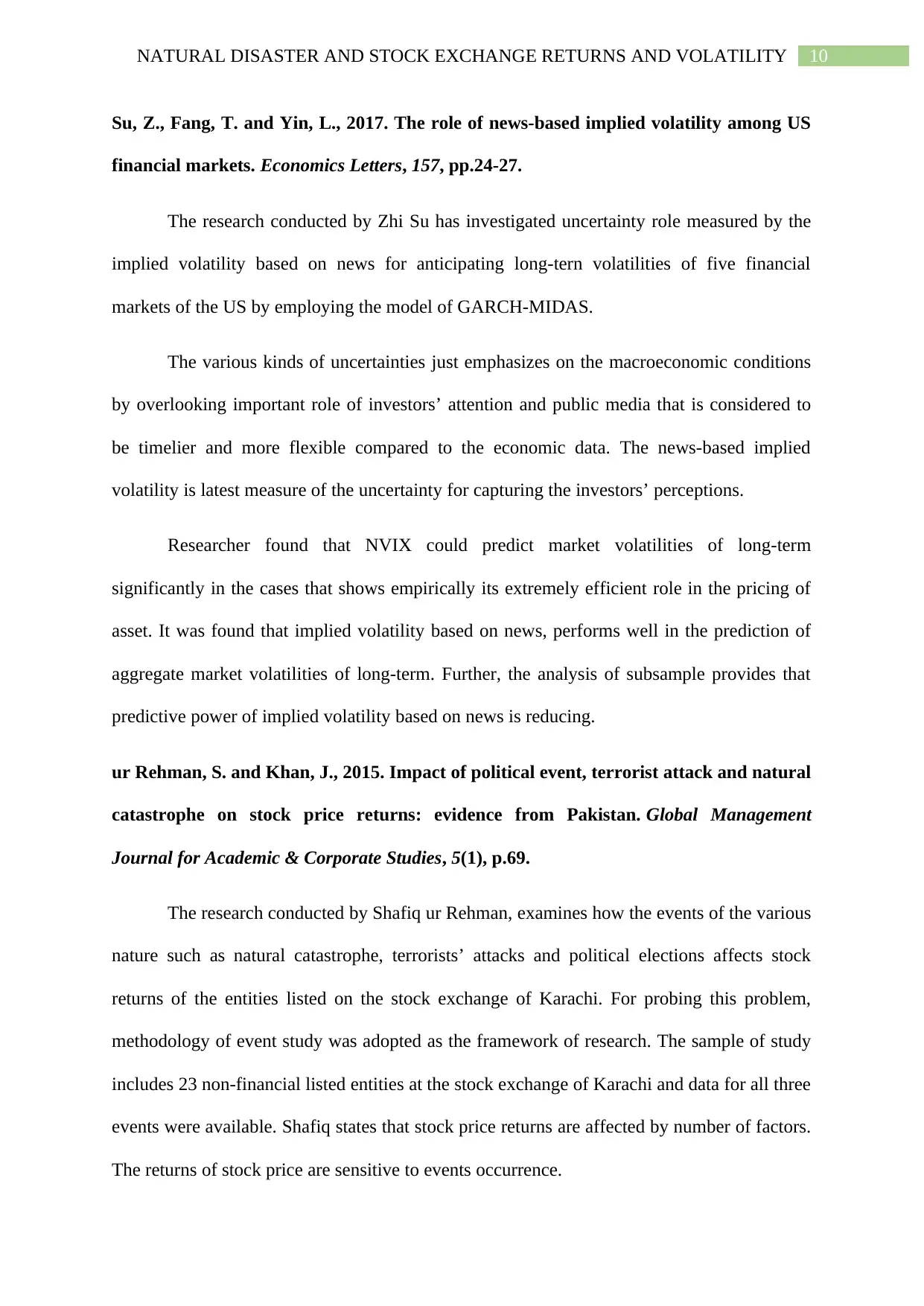
10NATURAL DISASTER AND STOCK EXCHANGE RETURNS AND VOLATILITY
Su, Z., Fang, T. and Yin, L., 2017. The role of news-based implied volatility among US
financial markets. Economics Letters, 157, pp.24-27.
The research conducted by Zhi Su has investigated uncertainty role measured by the
implied volatility based on news for anticipating long-tern volatilities of five financial
markets of the US by employing the model of GARCH-MIDAS.
The various kinds of uncertainties just emphasizes on the macroeconomic conditions
by overlooking important role of investors’ attention and public media that is considered to
be timelier and more flexible compared to the economic data. The news-based implied
volatility is latest measure of the uncertainty for capturing the investors’ perceptions.
Researcher found that NVIX could predict market volatilities of long-term
significantly in the cases that shows empirically its extremely efficient role in the pricing of
asset. It was found that implied volatility based on news, performs well in the prediction of
aggregate market volatilities of long-term. Further, the analysis of subsample provides that
predictive power of implied volatility based on news is reducing.
ur Rehman, S. and Khan, J., 2015. Impact of political event, terrorist attack and natural
catastrophe on stock price returns: evidence from Pakistan. Global Management
Journal for Academic & Corporate Studies, 5(1), p.69.
The research conducted by Shafiq ur Rehman, examines how the events of the various
nature such as natural catastrophe, terrorists’ attacks and political elections affects stock
returns of the entities listed on the stock exchange of Karachi. For probing this problem,
methodology of event study was adopted as the framework of research. The sample of study
includes 23 non-financial listed entities at the stock exchange of Karachi and data for all three
events were available. Shafiq states that stock price returns are affected by number of factors.
The returns of stock price are sensitive to events occurrence.
Su, Z., Fang, T. and Yin, L., 2017. The role of news-based implied volatility among US
financial markets. Economics Letters, 157, pp.24-27.
The research conducted by Zhi Su has investigated uncertainty role measured by the
implied volatility based on news for anticipating long-tern volatilities of five financial
markets of the US by employing the model of GARCH-MIDAS.
The various kinds of uncertainties just emphasizes on the macroeconomic conditions
by overlooking important role of investors’ attention and public media that is considered to
be timelier and more flexible compared to the economic data. The news-based implied
volatility is latest measure of the uncertainty for capturing the investors’ perceptions.
Researcher found that NVIX could predict market volatilities of long-term
significantly in the cases that shows empirically its extremely efficient role in the pricing of
asset. It was found that implied volatility based on news, performs well in the prediction of
aggregate market volatilities of long-term. Further, the analysis of subsample provides that
predictive power of implied volatility based on news is reducing.
ur Rehman, S. and Khan, J., 2015. Impact of political event, terrorist attack and natural
catastrophe on stock price returns: evidence from Pakistan. Global Management
Journal for Academic & Corporate Studies, 5(1), p.69.
The research conducted by Shafiq ur Rehman, examines how the events of the various
nature such as natural catastrophe, terrorists’ attacks and political elections affects stock
returns of the entities listed on the stock exchange of Karachi. For probing this problem,
methodology of event study was adopted as the framework of research. The sample of study
includes 23 non-financial listed entities at the stock exchange of Karachi and data for all three
events were available. Shafiq states that stock price returns are affected by number of factors.
The returns of stock price are sensitive to events occurrence.
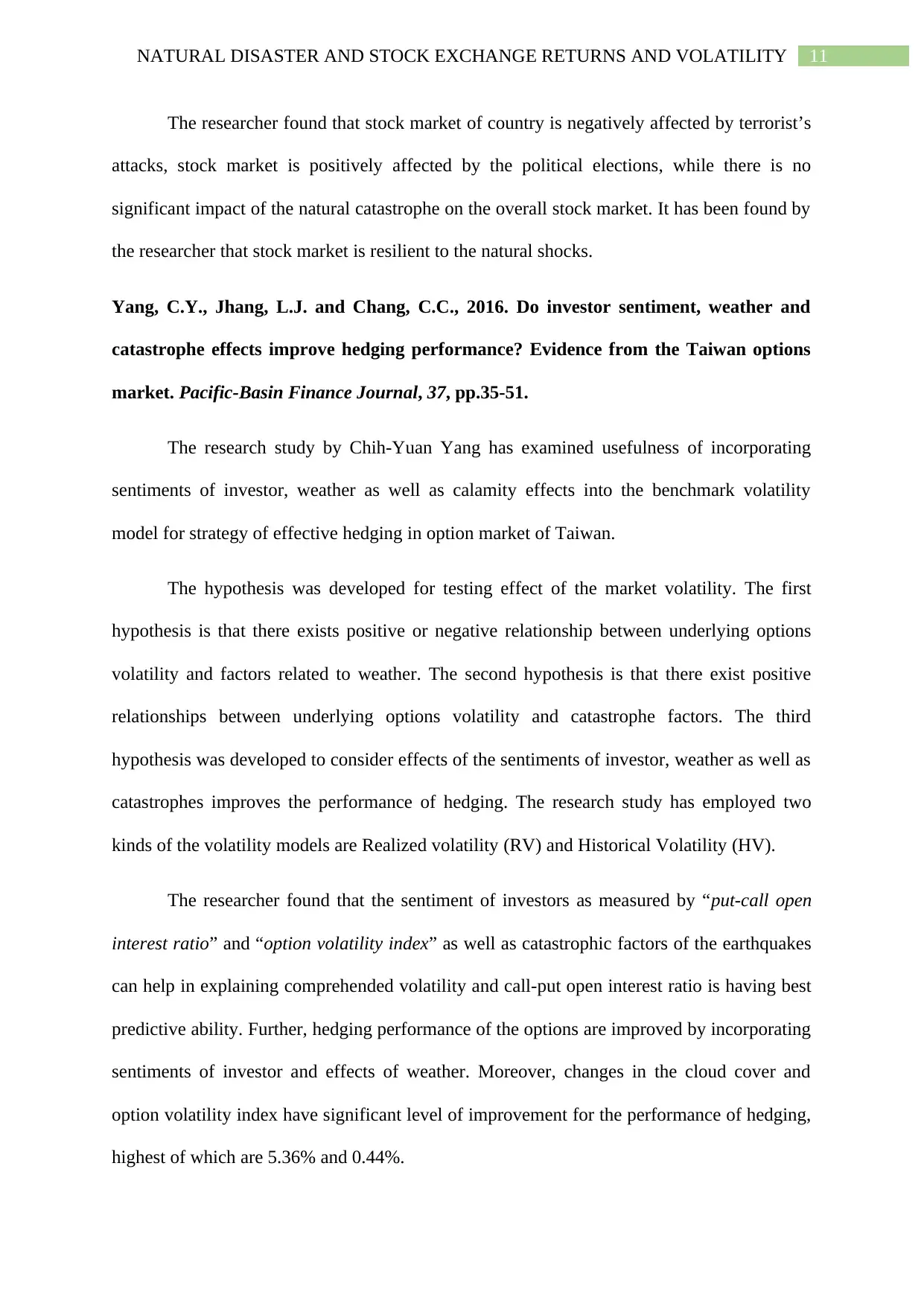
11NATURAL DISASTER AND STOCK EXCHANGE RETURNS AND VOLATILITY
The researcher found that stock market of country is negatively affected by terrorist’s
attacks, stock market is positively affected by the political elections, while there is no
significant impact of the natural catastrophe on the overall stock market. It has been found by
the researcher that stock market is resilient to the natural shocks.
Yang, C.Y., Jhang, L.J. and Chang, C.C., 2016. Do investor sentiment, weather and
catastrophe effects improve hedging performance? Evidence from the Taiwan options
market. Pacific-Basin Finance Journal, 37, pp.35-51.
The research study by Chih-Yuan Yang has examined usefulness of incorporating
sentiments of investor, weather as well as calamity effects into the benchmark volatility
model for strategy of effective hedging in option market of Taiwan.
The hypothesis was developed for testing effect of the market volatility. The first
hypothesis is that there exists positive or negative relationship between underlying options
volatility and factors related to weather. The second hypothesis is that there exist positive
relationships between underlying options volatility and catastrophe factors. The third
hypothesis was developed to consider effects of the sentiments of investor, weather as well as
catastrophes improves the performance of hedging. The research study has employed two
kinds of the volatility models are Realized volatility (RV) and Historical Volatility (HV).
The researcher found that the sentiment of investors as measured by “put-call open
interest ratio” and “option volatility index” as well as catastrophic factors of the earthquakes
can help in explaining comprehended volatility and call-put open interest ratio is having best
predictive ability. Further, hedging performance of the options are improved by incorporating
sentiments of investor and effects of weather. Moreover, changes in the cloud cover and
option volatility index have significant level of improvement for the performance of hedging,
highest of which are 5.36% and 0.44%.
The researcher found that stock market of country is negatively affected by terrorist’s
attacks, stock market is positively affected by the political elections, while there is no
significant impact of the natural catastrophe on the overall stock market. It has been found by
the researcher that stock market is resilient to the natural shocks.
Yang, C.Y., Jhang, L.J. and Chang, C.C., 2016. Do investor sentiment, weather and
catastrophe effects improve hedging performance? Evidence from the Taiwan options
market. Pacific-Basin Finance Journal, 37, pp.35-51.
The research study by Chih-Yuan Yang has examined usefulness of incorporating
sentiments of investor, weather as well as calamity effects into the benchmark volatility
model for strategy of effective hedging in option market of Taiwan.
The hypothesis was developed for testing effect of the market volatility. The first
hypothesis is that there exists positive or negative relationship between underlying options
volatility and factors related to weather. The second hypothesis is that there exist positive
relationships between underlying options volatility and catastrophe factors. The third
hypothesis was developed to consider effects of the sentiments of investor, weather as well as
catastrophes improves the performance of hedging. The research study has employed two
kinds of the volatility models are Realized volatility (RV) and Historical Volatility (HV).
The researcher found that the sentiment of investors as measured by “put-call open
interest ratio” and “option volatility index” as well as catastrophic factors of the earthquakes
can help in explaining comprehended volatility and call-put open interest ratio is having best
predictive ability. Further, hedging performance of the options are improved by incorporating
sentiments of investor and effects of weather. Moreover, changes in the cloud cover and
option volatility index have significant level of improvement for the performance of hedging,
highest of which are 5.36% and 0.44%.
⊘ This is a preview!⊘
Do you want full access?
Subscribe today to unlock all pages.

Trusted by 1+ million students worldwide
1 out of 15
Your All-in-One AI-Powered Toolkit for Academic Success.
+13062052269
info@desklib.com
Available 24*7 on WhatsApp / Email
![[object Object]](/_next/static/media/star-bottom.7253800d.svg)
Unlock your academic potential
Copyright © 2020–2025 A2Z Services. All Rights Reserved. Developed and managed by ZUCOL.


